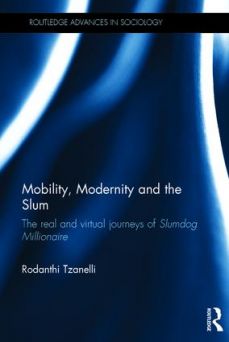Mobility, Modernity and the Slum: The real and virtual journeys of Slumdog Millionaire

Mobility, Modernity and the Slum spans multiple fields: cultural sociology, urban studies, development, and more. These varied perspectives meet to discuss “Slumdog Millionaire”, the award-winning 2008 film that follows a “slumdog” contestant of an Indian game show. The film is often treated as a postcolonial take on Dickens, with a rags to riches plot as well as subplots depicting neglect and abuse of the urban poor, particularly children. According to Rodanthi Tzanelli, it “moves from a grim vision of a ruinous city that can heal its wounds of migration, national partition and inequality”.
In Tzanelli’s analysis, “Slumdog Millionaire” both is and isn’t about modern India. The film’s choices reflect Western aesthetic preferences, such as a toning down of the melodrama associated with Bollywood, casting of Indian diaspora actors, and presentation of social realist themes in a highly simplified good vs. evil manner.
These choices extend to the film’s depictions of India. The protagonist works in a call centre, after all – perhaps the most immediate touchstone for visualizing a globalizing India. And the informal settlement Dharavi is presented in a way that may chime more with Western viewers’ understanding of India than the lived reality. For one thing, Mumbai’s informal settlements have the highest literacy rates of any in India, yet the film presents Dharavi as largely illiterate. It is also argued that, apart from the love story, films in the tradition of “Slumdog Millionaire” are preoccupied with the universalizing agenda exemplified by the Millennium Development Goals: poverty, gender equality, education, global partnership, etc. Therefore, despite the filmmakers’ intention to treat Mumbai as one of the most important characters, the setting of the film may not be a very specific one.
The book’s extensive film and media analysis is highly theoretical, with elaborations of aesthetic concepts and language. More grounded is the discussion of how tourism in Mumbai has been shaped by the film. “Slumdog Millionaire” has generated tourism to two icons of Indian modernity: the Taj Mahal (sparking a conversation about heritage preservation) and Dharavi (whose experience with the “tourist gaze” is more recent). The latter is part of a controversial trend toward slum tourism around the world. In Mumbai, this development includes walking tours that lead visitors to such sites as public toilets and waste heaps, as well as e-tours and internet-based digital activism. The increased international interest in Dharavi may have contributed to the local government’s desire to redevelop the settlement. So the residents of the area, who were the inspiration for “Slumdog Millionaire”, may end up being dislocated by the film’s success.
Another controversy connected to the film surrounded the child actors, who lived in Mumbai’s informal settlements, and the filmmakers’ responsibility for them. The production covered the children’s living and educational costs, and established a trust fund to be used for college. However, the money led to disputes among the children’s families, reported abuse, and allegedly the attempted sale of one of the children. This sparked a conversation about globalized entitlement and obligation, and the way urban childhood is framed in different regions.
Thus, the film has many implications beyond its content. Whatever the direction of influence, “Slumdog Millionaire” has driven much attention to a space that often gets ignored, making for interesting conversations around perceptions of Mumbai.
Further reading:
Arputham, Jockin (2008), “Developing new approaches for people-centred development”, Environment and Urbanization, Vol 20, No 2, pages 319–337, available at http://eau.sagepub.com/content/20/2/319.full.pdf+html.
Arputham, Jockin and Sheela Patel (2010), “Recent developments in plans for Dharavi and the airport slums in Mumbai”, Environment and Urbanization Vol 22, No 2, pages 501–504, available at http://eau.sagepub.com/content/22/2/501.abstract.
Environment and Urbanization (1989), “Beyond the stereotype of slums; how poor people find accommodation in Third World cities”, Vol 1, No 2, available at http://eau.sagepub.com/content/1/2.toc.
Prasad, M Madhava (2001), “Realism and Fantasy in Representations of Metropolitan Life in Indian Cinema”, Journal of the Moving Image Vol 2, available at http://www.jmionline.org/article/realism_and_fantasy_in_representations_of_metropolitan_life_in_indian_cinema.
Book note prepared by Christine Ro
Search the Book notes database
Our Book notes database contains details and summaries of all the publications included in Book notes since 1993 - with details on how to obtain/download.
Use the search form above, or visit the Book notes landing page for more options and latest content.
For a searchable database for papers in Environment and Urbanization, go to http://eau.sagepub.com/

